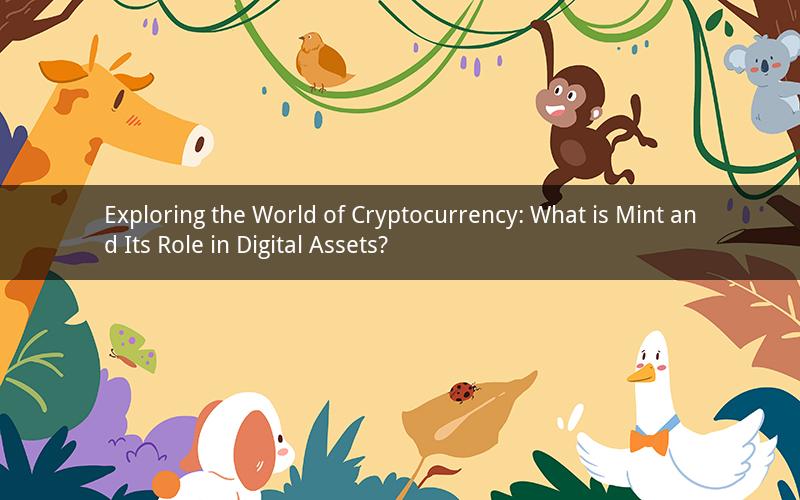
In the rapidly evolving landscape of digital finance, cryptocurrencies have become a prominent asset class. Among these digital assets, minting plays a crucial role in the creation and management of new tokens. This article aims to delve into the concept of minting in cryptocurrency, its significance, and the various aspects surrounding it.
Understanding Minting in Cryptocurrency
At its core, minting in cryptocurrency refers to the process of creating new units of a digital currency. Unlike traditional fiat currencies, which are issued and controlled by central banks, cryptocurrencies operate on decentralized networks. The minting process ensures the supply of these digital assets and governs their distribution among users.
How Does Minting Work?
The minting process varies depending on the specific cryptocurrency. In most cases, it involves the following steps:
1. Mining: In Proof of Work (PoW) cryptocurrencies like Bitcoin, minting occurs through mining. Miners use powerful computers to solve complex mathematical puzzles, and once a puzzle is solved, they are rewarded with new coins.
2. Staking: In Proof of Stake (PoS) cryptocurrencies, minting is achieved through staking. Users with a certain amount of coins lock them in a smart contract, and in return, they receive rewards for participating in the minting process.
3. Airdrop: Some cryptocurrencies distribute new coins to users through airdrops, which are promotional events. Participants usually need to hold or register their wallet addresses to receive free coins.
The Significance of Minting
Minting serves several critical functions in the cryptocurrency ecosystem:
1. Supply Control: Minting ensures a controlled supply of digital assets, preventing inflation and maintaining value. The process often includes predetermined rules, such as a fixed supply cap or inflation rate.
2. Reward Mechanism: Minting rewards participants for contributing to the network, whether through mining, staking, or other means. This incentivizes users to engage in the minting process and promotes network security.
3. Token Distribution: Minting facilitates the distribution of new coins to users, ensuring a fair and transparent process. It also allows for community-driven initiatives, as new tokens can be minted for specific projects or partnerships.
4. Innovation and Growth: Minting supports the continuous development of the cryptocurrency ecosystem by enabling the creation of new tokens with unique features and use cases.
Common Minting Cryptocurrencies
Several well-known cryptocurrencies utilize minting as part of their ecosystem:
1. Bitcoin (BTC): The first and most famous cryptocurrency, Bitcoin, uses mining to mint new coins. Its supply is capped at 21 million.
2. Ethereum (ETH): Ethereum, the second-largest cryptocurrency by market capitalization, employs a PoS minting mechanism called Ethereum 2.0. The network aims to achieve better scalability and security.
3. Binance Coin (BNB): Binance Coin is an ERC-20 token that serves as the native currency of the Binance exchange. It is minted through the exchange's trading fees and distributed to users as rewards.
4. Cardano (ADA): Cardano is a PoS cryptocurrency that focuses on sustainability and scalability. Its minting process is designed to ensure a fair and energy-efficient network.
5. Polkadot (DOT): Polkadot is a cross-chain interoperability platform that utilizes a unique minting process to create new tokens. Users can participate in minting by staking DOT tokens and earning rewards.
Frequently Asked Questions (FAQs)
1. What is the difference between minting and mining?
Answer: Mining is a process used in PoW cryptocurrencies to solve mathematical puzzles and mint new coins. Minting, on the other hand, is a broader term that includes mining, staking, and other processes used to create and manage digital assets.
2. Can the supply of a cryptocurrency be increased through minting?
Answer: Yes, in many cryptocurrencies, the supply can be increased through minting. This is often done to finance network development or distribute new tokens to community members.
3. Is minting secure?
Answer: The security of minting depends on the underlying technology and the cryptocurrency's consensus mechanism. PoW and PoS cryptocurrencies generally offer a high level of security, but vulnerabilities can still exist.
4. Can minting be stopped?
Answer: In some cryptocurrencies, minting can be paused or adjusted through network upgrades or governance processes. However, in others, minting is an inherent part of the network and cannot be stopped.
5. How does minting affect the value of a cryptocurrency?
Answer: Minting can have a significant impact on the value of a cryptocurrency. A controlled supply and fair distribution can increase its value, while an excessive supply or lack of transparency can lead to a decrease in value.